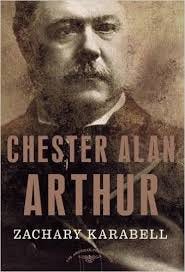The Book, the Man, and the Venue — Chester Arthur
Book Review — "Chester Alan Arthur: The American Presidents Series" by Zachary Karabell
Welcome back to “The Book, the Man and the Venue”, my weekly newsletter that aims to shed light on every U.S. president in a way that is engaging, informative, and hopefully, fun!
Every Monday, I’ll be releasing a new article in which I chronicle my journey through one biography for each U.S. President. Each post will consist of three parts: I’ll offer a brief review of the biography (the Book), share reflections on the president’s character and legacy (the Man), and choose a location where I would spend time with the president if they were alive today (the Venue).
Hopefully, you will find the content both enriching and enjoyable, and if you like what you read, please consider checking out my other articles (and subscribing if you don’t already)!
Without further ado: Chester Arthur
The Book
“Chester Alan Arthur” by Zachary Karabell is the sixth book from the American Presidents Series (APS) that I have read, and it delivered the consistent quality that I’ve come to expect. Despite its brevity – I read Karabell’s 143 page book in one sitting – the author outlines the important aspects of Arthur’s life in a way that is direct, mechanical, and satisfying.
Throughout the book, Karabell skillfully elucidates the broad themes of Arthur’s life. From his interests in high fashion and fine dining to his redecoration of the White House and presidential carriage, the reader gets a sense of Arthur’s vibrant personality while simultaneously understanding the broader political context of the Gilded Age. I especially appreciated Karabell’s nuanced discussion of patronage and government structure, and found his explanation of Arthur’s stance on the Chinese Exclusion Act to be both sensitive and acute.
Further, Karabell’s analysis of the Pendleton Act was outstanding. I take notes on every biography that I read, and have nearly the entire last two pages of Chapter 7 highlighted in my book. Karabell’s epilogue, though brief, is especially well-written. A more apt description of Arthur’s presidency cannot be written than this:
“For those who want presidents to be heroes, and, failing that, villains, for those who expect them to be larger-than-life figures, Arthur’s tenure in office isn’t satisfying. The nature of our expectations would have to change dramatically for Arthur to be reevaluated as one of this country’s best presidents. And yet, in spite of what Shakespeare wrote, some men are neither born great, nor achieve greatness, nor have it thrust upon them. Some people just do the best they can in a difficult situation, and sometimes that turns out just fine.”
Despite its merits, the book still has its flaws. It tends to oversimplify Arthur’s rise to power and misses the personal anecdotes that bring history to life. The reader receives only a limited view of Arthur’s relationships with both Roscoe Conkling and Julia Sand (more on this below), and the complexities of his governance style as president are not fully explored. At times, the book’s arguments lack subtlety and emotional depth, making it less impactful than a longer work might have been.
Nonetheless, for a book of its length, “Chester Alan Arthur” met my expectations. While it may not offer groundbreaking revelations about Arthur's life or legacy, it provides a concise and effective overview to an under-discussed president. Certainly, it is worth the read for anyone looking to quickly familiarize themselves with the “Gentleman Boss”.
Rating: 6.0/10
The Man
All great animated television shows have their fair share of filler. In Dragon Ball Z, the viewer must endure roughly 38 episodes of veritable nonsense before they are gratified by the final showdown of the Cell Saga. Similarly, in Batman: the Animated Series, episodes such as “I’ve got Batman in My Basement” and “Moon of the Wolf” must be painfully combed over in order to reach gems like “Over the Edge”, “Heart of Ice”, and “Perchance to Dream.”
Every so often, however, you come across a filler episode that outshines the main plot. Take “the Tales of Ba Sing Se” (Season 2, Episode 15) from Avatar: the Last Airbender. Sure, it does nothing to advance Aang’s journey through the Earth Kingdom — one can skip the episode and still follow the rest of the show — but it adds flavor and depth to the characters, reminding us why we care about the broader conflict in the first place (also who doesn’t love Leaves from the Vine !!).
This is how I have come to view Chester Arthur’s presidency. While Arthur’s story might seem like a filler episode in the grand presidential narrative, it is one that brings drama, intrigue, heroism, and redemption into the vibrant pages of US history.
Consider Arthur’s path to the presidency. Throughout his adult life, Arthur was a dedicated Stalwart, climbing the ranks of his career largely through the patronage and guidance of Roscoe Conkling. He was a man who “thrived in a system of assessments and paybacks,” a living representation of the corruption and deception that had become a hallmark of the political system.
Then came Charles Guiteau, an assassin who, before shooting the president of the United States, declared himself “a Stalwart of Stalwarts” with the aim of making Arthur president! Arthur was now thrust into a position he didn’t want, leading a nation who didn’t trust him, in circumstances that had never been encountered. Take this article from the Louisville Courier Journal:
“Mrs. [Mary] Surratt [of the Lincoln murder conspiracy] was hanged on less circumstantial evidence than occurs to the mind as to Roscoe Conkling and Chester A. Arthur. The vile nature of the contest at Albany, the despicable rancor of the combatants and the base methods accepted by both parties render murder as likely a weapon as any other, and whilst we should be loath to accuse anybody, and pray that the man Guiteau is not the instrument of a conspiracy, we should not be eager to assume the innocence of a body of political wretches…. who may have planned this assassination as their last redout.”
And then, in his most trying times, Arthur received a letter from Julia I. Sand, a bed-ridden thirty-one-year-old New Yorker who had closely followed New York politics her whole life. She understood Arthur’s potential for good from his days as an abolitionist lawyer, and urged him to rise to the occasion. As she wrote:
"The hours of Garfield's life are numbered—before this meets your eye, you may be President. The people are bowed in grief; but—do you realize it?—not so much because he is dying, as because you are his successor."
Sand continued:
"What President ever entered office under circumstances so sad! The day he was shot, the thought rose in a thousand minds that you might be the instigator of the foul act. Is not that a humiliation which cuts deeper than any bullet can pierce? Your best friends said: 'Arthur must resign—he cannot accept office, with such a suspicion resting upon him.' And now your kindest opponents say: 'Arthur will try to do right'—adding gloomily—'He wont succeed, though—making a man President cannot change him.
But making a man President can change him! Great emergencies awaken generous traits which have lain dormant half a life. If there is a spark of true nobility in you, now is the occasion to let it shine. Faith in your better nature forces me to write to you—but not to beg you to resign. Do what is more difficult & brave. Reform! It is not proof of highest goodness never to have done wrong, but it is proof of it, sometimes in ones career, to pause & ponder, to recognize the evil, to turn resolutely against it…. Disappoint our fears. Force the nation to have faith in you. Show from the first that you have none but the purest of aims.”
And you know what? Arthur did reform! Sure, he didn’t possess Washington’s leadership, Jefferson’s eloquence, or Lincoln’s resolve. But he did have the honesty and courage to navigate a tumultuous time and offer a steady hand to a country in need. And sometimes, that kind of steadiness is all we can ask for.
PS: Julia Sand wrote a total of 23 letters to Chester Arthur throughout his presidency. Although Arthur did not reply to her letters in writing, he saved them all in a special folder and even made an unexpected visit to see her in the summer of 1882. Today, these letters are preserved in the Library of Congress and are available for public viewing. Someone, PLEASE make the Chester Arthur movie!!!
The Venue
Chester Arthur was a frequent visitor to Delmonico’s Restaurant, a prestigious venue on 5th Avenue renowned for its exquisite dining and opulent atmosphere. As Karabell notes:
“Until he became president, Chester Arthur used the Fifth Avenue Hotel and Delmonico’s as his offices. They were where he met with the Astors and the Goulds, the Morgans and the Conklings, the patrons and the robber barons. They were where promises were exchanged; where donors pledged money; where candidates were selected. They were where power was.”
Although the original Delmonico’s on Fifth Avenue is no longer in operation, a new location has opened at the intersection of Beaver and William Street. Like Chet, I too appreciate fine dining, and would welcome the chance to unwind with some upscale cuisine. I only hope he picks up the tab at the end of the night.
I hope that you’ve enjoyed this installment of “The Book, the Man, and the Venue.” If you have feedback about today’s issue, or thoughts about future topics, please feel free to send me a message.
And if you liked it, please consider sharing (and subscribing if you don’t already)!







Love the reference to “the Tales of Ba Sing Se” in this review